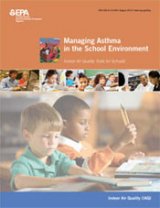Asthma - Improving Health in Communities and Schools

Información disponible en español
Asthma is a serious, life-threatening respiratory disease that affects millions of Americans, accounting for nearly two million emergency department visits each year. Read the Asthma Fact Sheet for the most up-to-date asthma statistics.
Although there is no cure, asthma can be controlled through medical treatment and management of environmental asthma triggers. In response to the growing asthma problem, EPA created a national, multifaceted education and outreach initiative to share information about indoor and outdoor environmental factors that trigger asthma.
On this page:
Improving Health in Communities
EPA mobilizes the following groups to identify and use the most effective community-based strategies for improving health outcomes for asthma and delivering high-quality asthma care to everyone in need:
- Community asthma programs;
- Health professionals;
- Health insurers;
- School nurses; and
- Health departments.
Our goal is to ensure that the management of environmental asthma triggers is integrated into overall asthma education programs.
NoAttacks.org
The National Childhood Asthma Media Campaign is a national public service effort created in collaboration with the Ad Council. The Campaign informs the public about how to prevent asthma attacks. The website NoAttacks.org offers downloadable radio, print, and television public service announcements in English, Spanish, and Tribal languages. Visit:
Improving Health in Schools
Approximately seven million children in the United States—an average of one out of every ten school-aged children—have asthma. Asthma is also a leading cause of school absenteeism. Every year, more than 10.5 million missed school days are attributed to this disease.
Since asthma affects so many children, asthma management should be a priority for every school! Controlling asthma as part of a comprehensive indoor air quality (IAQ) management program can lead to reduced absenteeism and increased student performance for students and staff. Follow the tips below to reduce asthma triggers and create a healthy indoor environment in your school.
Asthma triggers that affect children in schools include:
- Animal allergens;
- Cockroach and pest allergens;
- Mold and moisture;
- Dust mites; and
- Outdoor air pollutants (like ozone and particle pollution or school bus diesel exhaust).
Managing Asthma in the School Environment
EPA Resources
IAQ Tools for Schools Program
EPA developed the IAQ Tools for Schools Program to help schools reduce exposures to indoor environmental contaminants and manage asthma in the school environment. The IAQ Tools for Schools Action Kit helps schools identify, resolve and prevent indoor air quality problems using low and no-cost measures.
- View on-demand training webinars.
- Find an IAQ Champion. Schools and school districts have demonstrated a strong commitment to improving children's health by promoting good IAQ practices.
Integrated Pest Management in Schools
EPA recommends that schools use integrated pest management (IPM) to reduce pesticide risk and exposure to children. A school IPM program uses common sense strategies to reduce sources of food, water and shelter for pests in school buildings and grounds. An IPM program takes advantage of all pest management strategies, including the judicious and careful use of pesticides when necessary.
Clean School Bus USA
The goals of Clean School Bus USA are to reduce children's exposure to diesel exhaust and the amount of air pollution created by diesel school buses.

